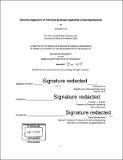Dynamic regulation of pathways by down-regulating competing enzymes
Author(s)
Tan, Sue Zanne
DownloadFull printable version (14.99Mb)
Other Contributors
Massachusetts Institute of Technology. Department of Chemical Engineering.
Advisor
Kristala L. J. Prather.
Terms of use
Metadata
Show full item recordAbstract
Microorganisms are promising hosts for the production of valuable chemicals, such as polymer and pharmaceutical precursors, fuel alternatives, flavors and fragrances. Achieving high yields of a product is often restricted by the interconnectivity of pathways in cells and finite nature of cellular resources. To overcome these limitations, dynamic pathway regulation has emerged as a strategy to balance flux between growth and production, such that titers and yields are maximized. Here, we demonstrate that dynamic pathway regulation by down-regulating competing enzymes can successfully improve yields of products. In Saccharomyces cerevisiae, we constructed a hexokinase valve where Hxk2 and GIk1 were deleted and the only remaining Hxk1 was placed under control of the tetracycline transactivating system (tTA) that enables repression of Hxk1 up to 10-fold in activity upon addition of doxycycline. Downregulation of this competing Hxk1 enzyme resulted in a 50-fold increase in gluconic acid and a 3-fold improvement in isobutanol yields from glucose. Extending this concept to other microorganisms, engineering downregulation of competing enzymes is dependent upon the ability to deplete a protein of interest in an inducible manner in the production host. In Pseudomonas spp., tools for specific protein depletion remain limited. Current methods involve promoter replacements and addition of degradation tags that require editing the genome, a process that can be laborious in Pseudomonas. Here, we developed a CRISPRi gene repression system by engineering the Streptococcus pasteurianus dCas9 and sgRNA. We demonstrate a robust and titratable gene depletion system, with up to 100-fold repression in [beta]-galactosidase activity in P. aeruginosa. We performed the first in vivo characterization of PAM site preferences of S. pasteurianus dCas9, revealing that targeting both NNGTGA and NNGCGA within the promoter can provide robust repression. Finally, the developed CRISPRi gene depletion system enabled the downregulation of competing muconate cycloisomerase in P. putida, leading to accumulation of muconic acid. In summary, we show that dynamic regulation of pathways by downregulating competing enzymes is an effective method to improve titers and yields of products. Controlling enzyme abundance at the transcriptional level proved successful with the existing tTA system in S. cerevisiae and with our developed CRISPRi system in Pseudomonas.
Description
Thesis: Ph. D., Massachusetts Institute of Technology, Department of Chemical Engineering, 2017. Cataloged from PDF version of thesis. Includes bibliographical references (pages 106-116).
Date issued
2017Department
Massachusetts Institute of Technology. Department of Chemical EngineeringPublisher
Massachusetts Institute of Technology
Keywords
Chemical Engineering.